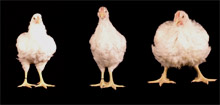 Those chickens give me the willies. Like the mythical boiled frog, I hadn’t been really aware of what has been done to the broiler chicken in the past 50 years. I knew, of course. But I didn’t know. Now, thanks to an almost incidental image on the web site of CBC news in Canada, I do. 1
Those chickens give me the willies. Like the mythical boiled frog, I hadn’t been really aware of what has been done to the broiler chicken in the past 50 years. I knew, of course. But I didn’t know. Now, thanks to an almost incidental image on the web site of CBC news in Canada, I do. 1
The reason for the CBC story, amplified in a press release from the University of Alberta, is that it is 50 years since the Poultry Scientists at the University of Alberta decided “to preserve a strain of broiler chicken to ensure it would live on”. The lovable boffins decided to celebrate with a bit of a party, which included a special feed for the hens, “topped off with birthday candles”. There is, of course, a serious point to all this: birds back then may have been five times smaller, and much slower growing, but they had some fine genes that the far-sighted scientists deemed worth preserving.
“At the time, it was thought by Agriculture Canada that genetic progress was happening pretty quickly and that a random-bred standard should be maintained to preserve those genetics,” said Doug Korver, a professor of poultry nutrition in the Faculty of Agriculture, Forestry, and Home Economics. “Preserving genetic stocks is important in poultry, because we use so few individual strains to produce a lot of the poultry in the world.”
“If we ever have to fall back on some traits that have been lost in the commercial genetic selection process, then we have that resource available to us to rely on again,” Martin Zuidhof told CBC News.
The crucial phrase is “random-bred”. Each year the scientists choose 400 eggs from 300 hens and use them to rejuvenate the flock. There is no selection, so the chances are good that all the genetic diversity is being preserved. Indeed, at a visible, phenotypic level, diversity is increasing. The original flock was all-white. Fifty years on, coloured birds stroll among their white brethren.
Among the invisible differences between the random-bred flock and modern selections is the response to infection. Modern birds do not divert many resources away from growth and into an immune response. “Old” birds mount a vigorous immune response, but at the expense of growth. It is this shift in priorities that underlies the almost unbelievable progress of the modern bird; it is selected to grow, quickly and efficiently, and infections are a distraction. The day may come when modern flocks need a better immune response, or maybe just resistance genes.
One of the issues is food security, said Zuidhof, citing the threat of bird flus, which wipe out entire flocks of chickens almost overnight. “Should something happen in the industry that caused a major loss of numbers, we have a strain that is unselected and closer to the indigenous chicken. It is just one more approach to securing the food supply going into the future.”
So how much has the modern bird changed? It is ready for the table in 35 days — that’s five weeks — versus the 90 days, almost 13 weeks, of its ancestor, which was already pretty well selected. Zuidhof reckons about 80% of the increase is down to genetics and just 20% to better nutrition and housing.
“People often assume that because chickens are so different from how they were 50 years ago, it must be to some technology like hormones. It’s all based on traditional selection of the best individuals and nutrition.”
Nevertheless, the scientists know that they don’t know when they might need to go back to the relatively unselected founder stock, hence the happy birthday to that genepool. And if its worth preserving the basis of the modern broiler flock, how much more important might it be to preserve the rest of the chicken’s genetic diversity?